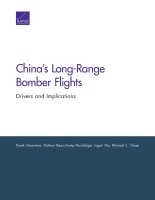| 来源类型 | Research Reports
|
| 规范类型 | 报告
|
| DOI | https://doi.org/10.7249/RR2567
|
| ISBN | 9781977400833
|
| 来源ID | RR-2567-AF
|
| China's Long-Range Bomber Flights: Drivers and Implications |
| Derek Grossman; Nathan Beauchamp-Mustafaga; Logan Ma; Michael S. Chase
|
| 发表日期 | 2018
|
| 出版年 | 2018
|
| 页码 | 100
|
| 语种 | 英语
|
| 结论 |
Implications for the United States- Given the multiple benefits derived from long-range strategic bomber flights over the Asia-Pacific region, whether in the area of conventional strategic signaling, realistic training opportunities, coercion of Taiwan, or propaganda for domestic consumption, the United States should expect that Beijing will continue to pursue — and even ramp up — these activities for the foreseeable future.
- Chinese president Xi Jinping's intent is to modernize and professionalize the People's Liberation Army into a "world-class" force that aligns with his vision of a stronger, "rejuvenated" China, and this virtually guarantees that the PLAAF will enjoy generous top leadership support in the coming years.
- The U.S. Air Force and other decisionmakers tasked with handling the U.S. response to the bomber flights should not expect to be able to dissuade Chinese leaders from continuing down this path.
- China's next-generation long-range strategic bomber, dubbed the H-20, is expected to enter service in the 2020s and will likely have the range to reliably threaten U.S. targets beyond the Second Island Chain, including Guam and Hawaii. Its likely nuclear capability could have implications for U.S. extended deterrence and for assurance of U.S. allies and partners in the region.
- Going forward, the key objective for the United States and its allies and partners should be to determine how to mitigate any negative effects of Chinese bomber flights, which appear set to become an increasingly regular occurrence in the region.
|
| 摘要 |
- The United States could work with allies and partners to devise a strategy for dealing with these flights. One effective means of discouraging increasingly provocative flights could be to conduct joint intercepts with Japan. Another would be to conduct and publicize joint air defense exercises with affected countries to reinforce extended deterrence and signal China that the United States and its allies will not be intimidated. Further improving the air defenses and training of U.S. bases in Asia — especially in Guam — might also be considered. The United States should also work with partners to plan ahead for potentially more provocative flights in the future.
- Washington could consider increasing U.S. Air Force bomber flights in the region to respond to or even match People's Liberation Army Air Force flights. Such flights would demonstrate U.S. commitment to allies and partners.
- There should be increased awareness of PLAAF activities through greater foreign and U.S. government transparency.
- The U.S. government can disclose more information on the strategic and political intentions of Chinese bomber flights over disputed territories and the consequences of such provocative actions, especially noting that military and political coercion of rival claimants violates international norms for resolving territorial disputes. Similarly, increasing U.S. information sharing with allies and partners in the region, publicly or privately, about Chinese bomber flights would serve to reassure allies and likely bolster support for the U.S. presence in the region.
|
| 主题 | China
; Fighter Aircraft
; Military Strategy
; United States Air Force
|
| URL | https://www.rand.org/pubs/research_reports/RR2567.html
|
| 来源智库 | RAND Corporation (United States)
|
| 引用统计 |
|
| 资源类型 | 智库出版物
|
| 条目标识符 | http://119.78.100.153/handle/2XGU8XDN/108900
|
推荐引用方式
GB/T 7714 |
Derek Grossman,Nathan Beauchamp-Mustafaga,Logan Ma,et al. China's Long-Range Bomber Flights: Drivers and Implications. 2018.
|
|
文件名:
|
x1542200966605.jpg
|
|
格式:
|
JPEG
|

|
文件名:
|
RAND_RR2567.pdf
|
|
格式:
|
Adobe PDF
|
除非特别说明,本系统中所有内容都受版权保护,并保留所有权利。